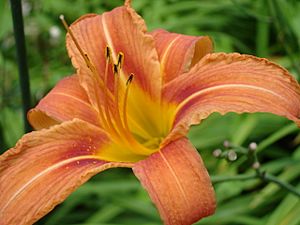Orange day-lily facts for kids
Quick facts for kids Orange day-lily |
|
|---|---|
 |
|
| Flower of Hemerocallis fulva var. fulva | |
| Scientific classification | |
| Synonyms | |
|
The orange day-lily (Hemerocallis fulva) is a popular flower from Asia. You might also hear it called the tawny daylily or ditch lily. It's grown all over the world in places with mild weather. People love it for its bright, showy flowers and because it's easy to grow. Even though it's called a "lily," it's not a true lily. It gets its name because its flowers look similar to real lilies. Each flower only blooms for one day, which is why it's called a "day-lily"!
Contents
What It Looks Like
The orange day-lily is a plant that grows back every year. It grows from special roots that look like small potatoes. Its stems can reach about 40 to 150 centimeters (1.3 to 5 feet) tall. The leaves are long and thin, growing up to 1.5 meters (5 feet) long. They are about 1.5 to 3 centimeters (0.6 to 1.2 inches) wide.
The flowers are usually 5 to 12 centimeters (2 to 5 inches) across. They are orange-red with a lighter line in the middle of each petal. These flowers bloom from early summer until late autumn. A single stem can have ten to twenty flowers. They open one after another, with each flower lasting only one day. After the flower fades, it forms a small, three-part seed pod. This pod is about 2 to 2.5 centimeters (0.8 to 1 inch) long. When it's ready, it splits open and releases tiny seeds.
How It Grows and Spreads
You can find different types of orange day-lilies in nature. Some have two sets of chromosomes (called diploid). Others have three sets (called triploid). Most of the plants grown in gardens are triploids. These triploid plants rarely make seeds. Instead, they mostly spread by growing underground stems called stolons. These stolons help new plants pop up nearby.
There are at least four main types, or varieties, of this plant. The most common garden type is the triploid var. fulva. Another type, var. Flore Pleno, has extra petals. This makes its flowers look very full.
Where It Lives
The orange day-lily is originally from Asia. It grows naturally from the Caucasus mountains all the way east through the Himalayas. You can also find it in China, Japan, and Korea.
Because it's so tough and easy to grow, it's a very good garden plant. It stays where it's planted and often spreads. In many parts of the United States and Canada, the orange day-lily has escaped from gardens. It now grows wild in many places. You can often see it along roadsides and in ditches, which is why it's sometimes called the "ditch lily." It can form thick patches that sometimes take over areas where native plants used to grow. People sometimes mistake it for a plant that naturally belongs there.
Growing Orange Day-Lilies
People have been growing Hemerocallis fulva in Europe since at least the 1500s. There are a few special types grown just for their beauty. Since most garden plants don't make seeds, new plants are usually grown by dividing the existing ones. This means you split a larger plant into smaller pieces.
These plants live for many years. They can adapt to many different garden conditions. They grow well even in tough spots where other plants might struggle. Orange day-lilies like lots of sun or light shade. They can also handle dry weather once they are established. They can survive cold winters down to USDA Zone 4.
Important Safety Note: It's good to know that all parts of day-lily plants can be harmful to pets, especially cats and dogs. Cats are particularly sensitive. It's best to keep your pets away from these plants.
Uses for People
Did you know that the flowers, leaves, and roots of the orange day-lily can be eaten? The young leaves and shoots can be eaten raw or cooked. But make sure they are very young, or they become too tough.
The flowers and young roots can also be eaten raw or cooked. The flowers taste even better when cooked. You can even fry them to store them for later. Or, you can dry them and use them to thicken soups. Cooked flower buds, served with butter, are said to taste a bit like green beans. The roots are a good substitute for potatoes.
See also
 In Spanish: Hemerocallis fulva para niños
In Spanish: Hemerocallis fulva para niños


